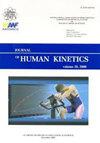24周Crossfit®训练后,男性和女性的血液学适应性不同吗?
IF 1.9
3区 医学
Q2 SPORT SCIENCES
引用次数: 0
摘要
经常锻炼可以通过改变白细胞、红细胞和其他典型血液标志物的数量和功能来调节免疫系统的功能。高强度运动促进细胞毒性活性、吞噬能力、趋化性和细胞凋亡的增加。该研究的目的是比较使用CrossFit®方法的24周训练计划对男性和女性血液学变量的慢性影响。29名CrossFit®运动员(35.3±10.4岁,175.0±9.2 cm, 79.5±16.4 kg)参与了这项研究。在研究期间,每两个月测量一次血液计数、血脂和血糖指标。男性和女性的红细胞计数和血红蛋白浓度分别在第4个月和第6个月增加。男性的红细胞压积水平在第2、4和6个月增加,而女性仅在第6个月增加。与第2个月相比,男性红细胞分布宽度在第6个月有所增加。第6个月,男性的节段性中性粒细胞增加,女性的嗜酸性粒细胞水平增加。在基线以及第2、4和6个月,观察到两性之间单核细胞水平的差异。交叉健身®训练增加了两性红细胞计数指标,这可能与红细胞生成增加有关。一些白细胞计数发生了改变,而且在性别之间存在差异。淋巴细胞数量在整个实验过程中保持稳定。本文章由计算机程序翻译,如有差异,请以英文原文为准。
Do Men and Women Differ in Hematological Adaptations to 24 Weeks of Crossfit® Training?
Regular exercise can modulate the immune system functioning through changes in the number and function of leukocytes as well as in red blood cells and other typical blood markers. High intensity exercise promotes increases in cytotoxic activity, phagocytic capacity, chemotaxis and cell apoptosis. The aim of the study was to compare the chronic effects of a 24-week training program using CrossFit® methodology on hematological variables of men vs. women. Twenty-nine CrossFit® athletes (35.3 ± 10.4 years, 175.0 ± 9.2 cm, 79.5 ± 16.4 kg) participated in the study. The blood count, the lipid profile and glucose markers were measured every two months during the study period. The erythrocyte count and hemoglobin concentrations increased in months 4 and 6 in men and women, respectively. Hematocrit levels increased in men in months 2, 4 and 6, while in women only in month 6. Red cell distribution width increased in men in month 6 when compared to the value in month 2. Segmented neutrophils increased in men in month 6 and eosinophil levels increased in women in month 6. Differences between the two sexes were observed in monocytes levels at baseline, as well as in months 2, 4 and 6. Cross-Fit® training increased red cell count indicators in both sexes, which may be related to increased erythropoiesis. Some white blood cell counts were altered and these differed between sexes. The number of lymphocytes remained stable throughout the experiment.
求助全文
通过发布文献求助,成功后即可免费获取论文全文。
去求助
来源期刊

Journal of Human Kinetics
医学-运动科学
CiteScore
4.80
自引率
0.00%
发文量
83
审稿时长
3 months
期刊介绍:
The Journal of Human Kinetics is an open access interdisciplinary periodical offering the latest research in the science of human movement studies. This comprehensive professional journal features articles and research notes encompassing such topic areas as: Kinesiology, Exercise Physiology and Nutrition, Sports Training and Behavioural Sciences in Sport, but especially considering elite and competitive aspects of sport.
The journal publishes original papers, invited reviews, short communications and letters to the Editors. Manuscripts submitted to the journal must contain novel data on theoretical or experimental research or on practical applications in the field of sport sciences.
The Journal of Human Kinetics is published in March, June, September and December.
We encourage scientists from around the world to submit their papers to our periodical.
 求助内容:
求助内容: 应助结果提醒方式:
应助结果提醒方式:


